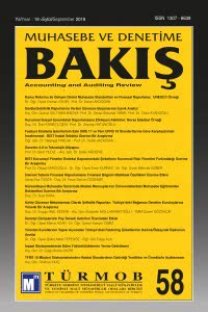YATIRIMCILARIN GERÇEĞE UYGUN DEĞER HİYERARŞİSİNE YÖNELİK ALGILARI ÜZERİNE BİR ÇALIŞMA
Gerçeğe Uygun Değer Hiyerarşisi, Finansal Tabloların Sunumu, Gözlemlenebilir ve Gözlemlenebilir Olmayan Girdiler
A RESEARCH ON INVESTORS’ FAIR VALUE JUDGMENTS
Fair Value Hierarchy Financial Report, Financial Statement Presentation, Observable and unobservable inputs,
___
- Aboody, David, Mary E. Barth ve Ron Kasznik, “Revaluations of Fixed Assets and Future Firm Performance,” Journal of Accounting and Economics, 1999, Vol. 26, s. 149–178.
- Barth, Mary, “Fair Values and Financial Statement Volatility,” Market Discipline across Countries and Indus- tries (Edt: Claudio Borio, William Curt Hunter, George Kaufman ve Kostas Tsatsaronis), MIT Press, Cambrid- ge, MA, 2004.
- Barth, Mary ve Greg Clinch, “Revalued Financial, Tangible, and Intangible Assets: Associations with Share Pri- ces and Non-Market-Based Value Estimates,” Journal of Accounting Research, 1998, Vol. 36, s. 199–233.
- Barth, Mary, William Beaver ve Wayne Landsman, “Value-Relevance of Banks’ Fair Value Disclosures under SFAS No. 107,” The Accounting Review, 1996, Vol. 71, No. 4, s. 513–553.
- Benston, George J., The Shortcomings of Fair-Value Accounting Described in SFAS 157, Journal of Accoun- ting and Public Policy, 2008, Vol. 27, No. 2, s. 101-114.
- Campbell, Ronald L, Lisa A. Owens ve Diana R. Robinson, “Fair Value Accounting From Theory to Practice,” Strategic Finance, 2008, Vol. 90, No. 1, s.31-37.
- Clor-Proell, Shana M., Chad A. Proell ve Terry D. Warfield, “The Effects of Presentation Salience and Measure- ment Subjectivity on Nonprofessional Investors’ Fair Value Judgments”, Contemporary Accounting Research, , Fourth Coming Issue.
- Fiechter, Peter, “The Effects of the Fair Value Option under IAS 39 on the Volatility of Bank Earnings,” Jour- nal of International Accounting Research, 2011, Vol. 10, No. 1, s. 85-108.
- Goncharov, I. ve Van Triest, S., “Do Fair Value Adjustments Influence Dividend Policy?,” Accounting and Bu- siness Research, 2011, Vol. 41, No. 1, s. 51-68.
- Hirst D. Eric, Patrick E. Hopkins ve James M. Wahlen, “Fair Values, Income Measurement, and Bank Analysts’ Risk and Valuation Judgments”, The Accounting Review, 2004, Vol. 79, No. 2, s. 453-472.
- Kothari, S.P., Karthik Ramanna ve Douglas J. Skinner, “Implications for GAAP from an Analysis of Positive Re- search in Accounting,” Journal of Accounting and Economics, 2010, Vol. 50, No. 2-3, s. 246-286.
- Laghi, Enrico, Sabrina Pucci, Marco Tutino ve Michele Di Marcantonio, “Fair Value Hierarchy In Financial Ins- trument Disclosure. Is There Transparency For Investors? Evidence From The Banking Industry, Journal of Go- vernance and Regulation, 2012, Vol. 1, No. 4, s. 23-38.
- Landsman, Wayne R., “Is Fair Value Accounting Information Relevant and Reliable? Evidence from Capital Market Research,” Accounting and Business Research, 2007, Special Issue: International Accounting Policy Forum, s. 19-30.
- Laux, Christian ve Christian Leuz, “The Crisis of Fair Value Accounting: Making Sense of the Recent Debate,” Accounting, Organizations and Society, 2009, Vol. 34, No. 6-7, s. 826-834.
- Lisa Koonce, Karen K. Nelson, ve Catherine M. Shakespeare, “Judging the Relevance of Fair Value for Finan- cial Instruments”, The Accounting Review, November 2011, Vol. 86, No. 6, s. 2075-2098.
- Maines, Laureen A., ve James M. Wahlen, “The Nature of Accounting Information Reliability: Inferences from Archival and Experimental Research,” Accounting Horizons, 2006, Vol. 20, s. 399–425.
- Muller, Karl A. ve Edward Riedl, “External Monitoring of Property Appraisal Estimates and Information Asy- mmetry,” Journal of Accounting Research, 2002, Vol. 40, s. 865–881.
- Penman, Stephen H., “Financial Reporting Quality: Is Fair Value a Plus or a Minus?,” Accounting and Business Research, 2007, Special Issue: International Accounting Policy Forum, s. 33-44.
- Penman, Stephen H., “Financial Forecasting, Risk and Valuation: Accounting for the Future,” Abacus, 2010, Vol. , No. 2, s. 211-228.
- Scott, William; Financial Accounting Theory, 3rd Edition, Prentice Hall; ABD, 2003.
- Song, Chang Joon, Wayne B. Thomas ve Han Yi, “Value Relevance of FAS No. 157 FairValue Hierarchy Infor- mation and the Impact of Corporate Governance Mechanisms,” The Accounting Review, 2010, Vol. 85, No. 4, s. 1375–1410.
- Sorin, Stan “Intangible Assets,” Guide to Fair Value under IFRS, (Edit: James P. Catty), John Wiley & Sons, Inc., New Jersey, USA, s. 316, 2011.
- Kamu Gözetimi, Muhasebe ve Denetim Standartları Kurumu “TFRS 13 Gerçeğe Uygun Değer Ölçümü,” TMS/TFRS Seti, Ankara, 2013.
- KAP; Kamuyu Aydınlatma Platformu, www.kap.gov.tr, 2013
- TSPAKB, Türkiye Sermaye Piyasası Aracı Kuruluşları Birliği, http://www.tspakb.org.tr, 2013.
- Türel, Ahmet, Gerçeğe Uygun Değer ile Finansal Raporlama; Ülkemizde Algılanması ve Uygulanması, Ya- yımlanmamış Doktora Tezi, İstanbul Üniversitesi, İstanbul, 2009.
- Watts Ross L. ve Jerold L. Zimmerman, “Positive Accounting Theory: A Ten Year Perspective,” The Accoun- ting Review, 1990, Vol. 65, No. 1, s. 131-156.
- Zyla, Mark L., Fair Value Measurements: Practical Guidance and Implementation, John Wiley & Sons, New Jersey, USA, 2010.
- ISSN: 1307-6639
- Yayın Aralığı: 3
- Başlangıç: 2000
- Yayıncı: TÜRMOB
HÜSEYİN ALİ KUTLU, Alper TAZEGÜL, Ümit Yaşar ELYILDIRIM
YATIRIMCILARIN GERÇEĞE UYGUN DEĞER HİYERARŞİSİNE YÖNELİK ALGILARI ÜZERİNE BİR ÇALIŞMA
ŞİRKET DENETÇİLİĞİNDEN BAĞIMSIZ DENETÇİLİĞE
GİRİŞİMCİLİK VE LOJİSTİK ARASI İLİŞKİYE AMPİRİK BİR YAKLAŞIM, ÖRNEK BİR FİRMA İNCELEMESİ
OTEL İŞLETMELERİNDE MUHASEBE BİLGİ SİSTEMİNİ ETKİLEYEN GÜNCEL GELİŞMELER
SÜREKLİ DENETİMİN UYGULANMA DÜZEYİ İLE İLGİLİ BIST 100 ŞİRKETLERİNDE BİR ARAŞTIRMA
